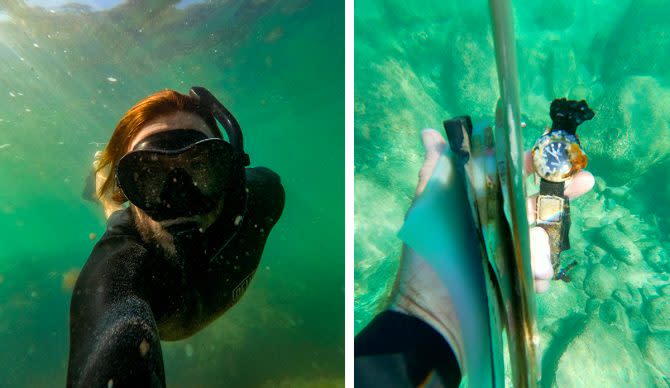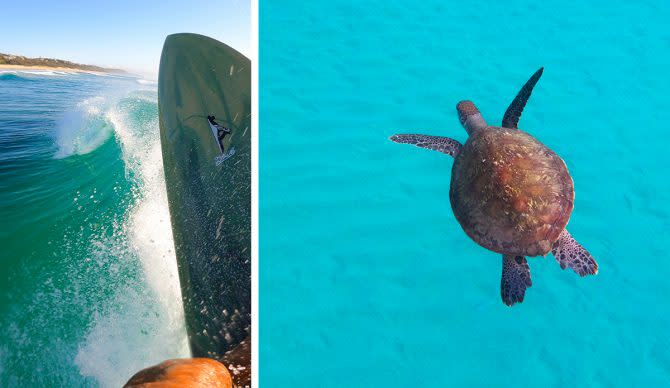What We Can Learn From Noosa’s ‘Aquatic Garbage Man,’ Who Found a $30,000 Rolex

As water people, we have infinite reasons, and need little convincing, to be in the ocean. Surf craft has evolved to seize on objectively unideal conditions. We can spend more time in the water than ever before. To enjoy the treasures of the sea, then, we’ve got a good old-fashioned moral obligation to protect our playground.
Self-proclaimed “Aquatic Garbage Man” and Aussie surfer, Matt Cuddihy, works to protect his playground with a passion we could all take inspiration from. You might have heard his name? Not just for his surfing, either. While on a trash-gathering mission near his Noosa home, he went viral for recovering a rare Rolex Submariner timepiece from the ocean floor and reuniting it with its humble owner who’d lost it in the surf four years before. (Full story here.)
But Matt mostly removes things that clutter our ocean with junk. So what can we learn from this trash-collecting waterman? Cuddihy shared a few thoughts with me recently.
Protect Your Mother and Respect Country
“Even if you don’t live near the ocean or feel the same connection, it’s our collective backyard and impacts everyone,” he said.
Matt’s a Noosa native, raised amongst nearly 30 kilometers of protected national park, surfing consistent swell and rolling points. Known by friends as “Cuddles,” notorious for sunrise photos captioned “good morning,” and park ranger-ing full-time, his efforts are nothing short of epic environmentalism. “I can’t remember not being in the surf. My oldest memory is falling off a board at Scott’s Head and staring at the bottom. I think I was three.” At 14, he started competing in the Noosa Malibu Club and Noosa Festival of Surfing.
“I was always outside, following fire breaks with friends, mountain biking or paddling old surfboards through flooded swamps,” he remembers. “Mum and dad told me to come home when the street lights came on, but being out bush, it was always tough to know when that was.”
A stint in California, exploring surf culture, waves and nature sparked his interest in becoming a park ranger to look after the places he loved. Rooted in land and sea, he’s all in on protecting his playground.
Home of the Kabi Kabi people, Noosa, from Noothera or Gnuthuru, means “shadow” or “shady place.” The surroundings all have an indigenous name tributing the native land and traditional owners.
“There aren’t many places on Australia’s east coast where you look out from the surf and don’t see houses. We’re lucky the generation before us protected the land from development and maintained a natural vision without highrises.”
“It’s important to know the local history, good and bad so you can appreciate it,” he continued.” There’s so much cultural and historical significance in Noosa that would probably change people’s perspective with greater respect. I saw old photos of Indigenous Australians from the early 1900s on Teewah. They had it dialed, thriving off the land without leaving a trace. We can learn from that. Then the other day, we were in an area of cypress trees. These conifers have been around for hundreds of years, and you often find pipis or oyster shells or bones where elders must have eaten under the cool shade. I see it and wonder how long that’s been there. Maybe hundreds of years the last time someone had a meal. And it’s just so cool, no one thinks twice about it. Just the way the land preserves that sort of stuff. There’s always something to learn.”
You Can Surf Here, Just Be Nice
From growing up surfing the points with the same mates he has today, Matt says, “Noosa’s being loved to death.”
“Growing up you knew everyone in the surf so it was always an endless chat of surf politics, traveling and telling stories of swells past,” he says. “Or the oldies would talk about Noosa from back in the day. A lot of that is slowly disappearing and locals have been priced out. Now you see different people out each time and it changes the dynamic.”
Etiquette and self awareness are imperative for being a decent human. Just because you’re good enough to catch every wave, doesn’t mean you should. “There’s nothing more annoying than a greedy person on a longboard,” he says.
“Look around, bring home whatever you brought to the beach, respect others and don’t go hassling for every wave. Sometimes, you go out there and see someone you don’t recognize going for every wave while some of the local older guys have been sitting out for an hour and haven’t caught any.”
If You Can Swim, Grab a Fin
“Don’t be partial,” he pleads. “Adopt the mentality that if you see something that doesn’t belong, pick it up even if it’s not yours. No one’s perfect, but it makes a big difference when everyone tries.”
Cuddles lives by that collectively learned concept from childhood, pick up after you play; ocean responsibility is on us. He’d love to see us normalize giving back to the places we visit rather than being complacent because it’s a holiday.
“I was working at the airport and when it shut down [during the pandemic] I spent most of my time at the points, surfing or snorkeling on high tide and collecting rubbish. That stemmed from seeing fishing lines wrapped around the rocks and my concern for the turtles. There was a government subsidy that financially kept me afloat and I’d use it to support local businesses, buying vinyls and food. And now as a ranger, I get paid to take care of where I live.”
He tries to snorkel once a week with a mesh bag and fills it with garbage wedged in the rocks and mostly fins, especially after a big swell, or chunks of foam and fiberglass. Or fishing lures, which he gives to friends hoping they won’t end up in the same place.

“I like giving the things I find a second life. I remember not finding anything once and thought, wait, that’s a good thing. The fiberglass fins are special with etchings and corrosion from life underwater. And little organisms and barnacles clinging to them.”
Matt draws inspiration from legendary Pipeline lifeguard and body surfer Mark Cunningham finding sunken fins and treasures on Oahu’s North Shore and displaying them as art on beachwood at exhibits.
A virtual display, Matt shares his haul on Instagram, like the Rolex that reached 25,000 people and connected him with the owner, a local guy Ric, who reclaimed and restored the nearly 50-year-old gift.
But, gold ain’t the goal and Matt’s not (yet) reaching for a metal detector.
“My mates have kids and I have spare time,” he says. “I’m in Noosa for the long haul so I’ll continue caring for my home.”
The post What We Can Learn From Noosa’s ‘Aquatic Garbage Man,’ Who Found a $30,000 Rolex first appeared on The Inertia.

